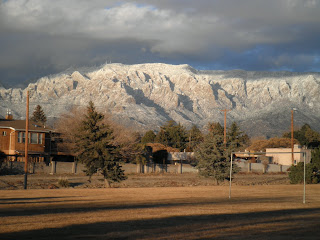 View of the Sandia Mountains from my neighborhood here in Alburquerque
View of the Sandia Mountains from my neighborhood here in Alburquerque.
इर्षा क्रोध भय शोक मनास्यामा प्रवर्तते
When ama is in the mind there will be fear, anger, and griefAccording to Ayurveda
ama is a raw, undigested, morbid, toxic substance that is a result from a previously disturbed dosha or the inability to completly digest food and experience. This substance further leads the body into lethargy, confusion, and the preliminary stages of disease. Having a sluggish digestive system is in many ways the root cause of the numerous problems our body comes into contact with, which can be avoided by a balancing diet and lifestyle. On a more subtle level, slow mental digestion is the root cause of many unresolved emotions and psychological disorders. In the sutra above, the unresolved emotions or sensory experiences will breed fear for the vata individual, anger for the pitta individual, and grief for the kapha all accumulating in their relative organs. A thought needs to be digested and processed just as food needs to be metabolized and utilized for energy and nourishment. When this fails to happen the undigested experience manifest as ama in areas of the body where the immune system is weak, which is known as a
khavaigunya. How is this problem approached and how is it resolved? Awareness. Pain, sadness, heartbreak, anger, fear, grief as well as happiness, pleasure, excitement are to be experienced in the light of awareness. To watch emotions rise and fall, to be fully present within your suffering and sorrow is the challenge but healing grace of ayurveda. Be the silent watcher of emotions, not reacting with attachment to a feeling but to fully experience it for what it is and let it leave on its own accord. The exhalation needs to be fully utilized, just as one wouldn't urinate half the amount of urine one should let all digested experience leave with the out breath. By this awareness a new reality dawns and the anger, fear, and grief of emotion looses its grip and can just be seen as the passing clouds within the clarity of the sky.



